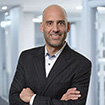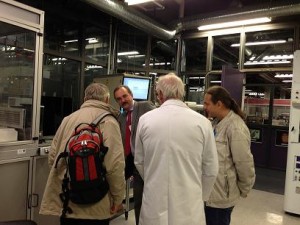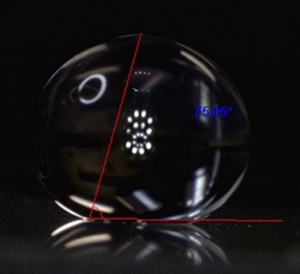
Dr. K. L. Mittal, Dr. Robert H. Lacombe
X-RAY PHOTOELECTRON SPECTROSCOPY – XPS
In last months issue of the INVISIBLE UNIVERSE essay series we established two fundamental reasons why surfaces remain essentially invisible to us even though they are the most common entity with which we interact every waking moment. The first reason was the fact that our eyes only detect about 2% of the radiation that any given surface can beam at us making us rely on special experimental technologies such as XPS in order to discern otherwise invisible surface structures. The second reason is that surfaces are subject to the laws of quantum mechanics which determines not only the details of surface structure but also governs the interactions of all forms of radiation with the atomic and molecular entities of which all surfaces are composed.
Last month’s discussion laid out the fundamental precepts of quantum theory and we now apply them to understand the workings of the XPS experiment.
As pointed out in last months discussion the essence of the XPS experiment is when an X-Ray ( a high energy photon) impinges on a surface causing an electron ( called a photo electron due to being ejected by a photon) to be ejected from the surface. The laws of quantum mechanics insure that the ejected electron will come off at a very specific energy which uniquely identifies the type of atom from which it was ejected. This fact is what makes the XPS experiment so useful in probing the chemistry of any given surface. To understand this better we need to understand a little more about how quantum mechanics determines the atomic and molecular structure of all matter.
The story basically begins with a series of experiments carried out by Hans Geiger and Ernst Marsden1 over the time period from 1908 to 1913 where they were bombarding gold foils with alpha particles and detecting how the particles were scattered. Up to that time no one really had any idea as to what to expect. The mechanics of materials at the time assumed all matter to be a sort of homogenous continuum and on the basis of that assumption the best guess was that the particles would pass straight through or be somehow absorbed by the material. What they found instead was that a fraction of the particles were scattered through large angles up to 180 degrees. Ernst Rutherford the Director of the Cavendish Laboratory commented on these remarkable results as follows:
It was quite the most incredible event that has ever happened to me in my life. It was almost as incredible as if you fired a 15-inch shell at a piece of tissue paper and it came back and hit you. On consideration, I realized that this scattering backward must be the result of a single collision, and when I made calculations I saw that it was impossible to get anything of that order of magnitude unless you took a system in which the greater part of the mass of the atom was concentrated in a minute nucleus. It was then that I had the idea of an atom with a minute massive centre, carrying a charge.
This remarkable insight led to the notion that atomic matter was something like a miniature solar system where electrons orbit a central nucleus much as earth and the planets orbit the sun. This all seemed quite plausible for a while since it was known that positive and negative particles attracted each other by an inverse square power law much as the sun attracts each of the planets. This notion quickly fell apart, however, since the then well known laws of electrodynamics unambiguously predicted that such a system would be unstable. Classical electrodynamics clearly predicted that the orbiting electrons would quickly radiate away their orbital energy and fall into the central nucleus.
The conundrum of how atomic matter manages to exist was solved only when physicists attacked the problem using the principles of quantum theory. In particular Schrödingers equation could be solved exactly for hydrogen, the simplest atom of all, and the resulting solution provided a remarkable template for working out the atomic structure of the rest of the periodic table and in fact provided the theoretical foundation of why the periodic table exists. The picture that emerged is that a typical atom consists of a small ultra dense positively charged nucleus surrounded by a cloud of electrons where each electron occupies what is called a quantum eigenstate with a very sharply defined quantized energy level.
At this point we have to wonder what on earth is a quantum eigenstate? To proceed further we need to pass through the looking glass into the nether world of atomic matter as describe quantum theory which is the most consistent and accurate description that we have. Ostensibly, from the work of Rutherford and his colleagues, the typical atom consists of negatively charged electrons somehow circulating around a positively charged center being held in a tightly contained cluster by the inverse square Coulomb interaction. The first thing to note is that the notion that the electrons circle around the nucleus in a manner similar to the way the planets circle around the Sun is completely out the window. The Heisenberg Uncertainty Principle in particular dictates that we cannot know, even in principle, where inside the atom a particular electron might be at any given time. All we can know is where the electron tends to spend most of its time, i.e. the probability of finding the electron at any given point at any given time instant. This comes about because quantum theory dictates that the state of any given electron is prescribed by what is known as a wave function which must be a solution of Schrödingers equation which leads us into the realm of some fairly abstract mathematics dealing with the solutions of differential equations. Sorting through the details of solving Schrödingers equation would lead us rather far into the hinterlands of differential equation theory but we don’t have to make that journey to appreciate the final result. The basic results that emerge from laboring through the details are as follows:
Figure: Approximate energy level diagram for atomic matter
1) The time independent solutions of Schrödingers equation which describe the atom at equilibrium are solutions to what is commonly known as an eigenvalue problem.
2) The typical eigenvalue problem states that the differential equation under consideration can have solutions only if certain key parameters have very specific values which arise out of the general eigenvalue solution procedure.
3) For the case of a simple atom such as hydrogen the key parameters are the spatial coordinates of the orbiting electron or what are commonly called its degrees of freedom. In Cartesian coordinates these are the (x,y,z) position values. For atoms it is more convenient to use spherical coordinates so instead of (x,y,z) we use (ρ,θ,φ) i.e. a radial coordinate plus two angular coordinates.
4) Thus, for the hydrogen atom the state of the electron is described by 3 eigenvalues one for each independent coordinate. For the radial coordinate ρ the eigenvalue is called n where n can be any integer 1,2,3 …4. For the angular coordinate θ the quantum number is designated by the integer l which must be less than or equal to n – 1 or in symbols l # n – 1. For the φ coordinate the eigenvalue number is designated by m which is subject to the constraint -l # m # +l
5) There is yet one more phantom degree of freedom the electron can have and that is its spin which is designated by the symbol σ and can take on only the values ±1/2. The electron spin is a wholly unexpected and mysterious degree of freedom that has to exist since it accounts for the magnetic moment of the electron.
Figure: Approximate energy level diagram for atomic matter
6) The final piece of the puzzle which completes the quantum
description is the Pauli exclusion principle which simply states that no two electrons within an atom can have exactly the same quantum numbers. Thus each electron must be described by different values of the numbers n,l,m and s.
The above half dozen results that arise out of solving Schrödingers equation for the hydrogen atom form the basis of the energy level diagram depicted in figure (1). Thus the energy of the electron which depends on all the degrees of freedom, but primarily on n, must also be quantized and therefore must be depicted by sharply defined discreet levels as shown in the figure.
This is really a rather wondrous result as it lets us piece together atomic structure and the periodic table from the simple hydrogen atom up to very complex multi electron structures. Lets cobble together the first few atoms to see how it works:
1) HYDROGEN: With only one electron which occupies the lowest energy level traditionally designated by the label s which stands for angular momentum l=0. The x axis labels in figure (1) correspond to the θ quantum number l and again by tradition is given the labels s, p, d, f … corresponding to the l values 0, 1, 2, 3, … respectively. So for the hydrogen electron in its lowest energy state corresponding to n = 1 it can only have l = 0 according to rule 5 above and thus m must also be 0 according to the same rule. The spin quantum number σ can be either ±1/2. Thus from the point of view of quantum theory the hydrogen electron is described by the following quadruplet of magic numbers (n,l,m,σ) = (1,0,0,1/2) where in the absence of any external magnetic field the spin quantum number σ could be either + or – ½.
2) HELIUM: As the process continues to more complex atoms with more electrons we simply fill the levels shown in figure (1) one by one always filling the lowest energy levels first so that at equilibrium the atom has the lowest possible energy. Helium has a nucleus with 2 protons and thus accommodates two electrons to achieve electrical neutrality and the lowest possible energy configuration has both electrons in the n = 1 quantum level with l = m = 0. Now the Pauli exclusion principle comes into effect and dictates that one electron will have spin value +1/2 and the other -1/2. By rule 6 above the n = 1 quantum level is now filled with one electron in the (1,0,0,+½) state and the other in the (1,0,0,-½) state. Once an n level has the maximum number of electrons allowed by the above rules it is said to be filled and atoms with a filled n level tend to be very stable. Thus helium is at a filled level and is predicted to be very stable as is well attested by experiment.
Figure: XPS spectrum of a clean silicon wafer
LITHIUM: Adding one more electron brings us to the element lithium with three electrons. The first two electrons go into the n = 1 state with l = 0 and σ = ±1/2. Since the n = 1 state is now filled the third electron has no choice but to move into the n = 2 level with l = 0 and σ = ½ which is the 2s level shown in figure(1).
HIGHER ATOMS: The process continues with the next element beryllium having 4 electrons completely filling the 1s and 2s levels. The next atoms consisting of boron through neon must move into the next higher angular momentum state with l = 1 and designated as the 2p level in figure(1). Since l = 1 now allows the m quantum number to take on the values -1, 0, +1 this level can hold up to 6 more electrons since each m level can accommodate 2 electrons by Pauli’s exclusion principle. So the next 6
electrons go into the 2p level in the diagram and account for boron through neon. At neon the 2p level is completely filled and neon is thus predicted to be a chemically stable molecule as is also born out in experiment. The process continues progressively filling the higher energy levels shown in figure(1) and terminates finally at uranium with 92 electrons and thus 92 protons in the nucleus. At this level of electric charge the electromagnetic forces in the nucleus reach a par with the normally much stronger nuclear forces and the nucleus itself becomes unstable and prone to fission. Thus uranium is the largest atom found naturally in the environment though even larger atoms have been produced in large accelerators they have very short lifetimes.
The above picture immediately implies that the electronic configurations of the different atoms provide unique tags for identifying each one since each configuration comes with a unique binding energy which is simply the energy required to remove an electron from a specific energy level into the void. Consider for example a fluorine atom sitting on a surface. The 1s electrons in fluorine have a binding energy of 17.4 ev (electron volts) so if we see electrons at this energy being emitted from the surface we know that fluorine must be present. This is the basic concept underlying the XPS experiment. The XPS spectrometer basically bombards the surface with X-rays which have sufficient energy to blast electrons bound to the various surface atoms out of their energy levels and then sorts the emitted electrons by their unique binding energies thus revealing which atoms are present at the surface. Also the XPS experiment samples only the very top layers of the sample since once an electron has been emitted from its energy level it cannot travel very far through the surrounding material since its electric charge causes it to interact strongly with all the surrounding atoms which can capture or deflect it back into the substrate. A free electron can typically go no more that about 100 angstroms through the material before being captured or deflected so in effect the electons which are ejected come from the top 100 angstroms of the surface effectively making XPS a surface sensitive technique.
Figure(2) shows an XPS spectrum of a nominally clean silicon wafer which as manufactured consists of 100% pure single crystal silicon. The XPS spectrometer, however, reveals a surprisingly different picture of the surface of the wafer. Those in the microelectronics industry know that an initially clean silicon surface will react fairly rapidly with ambient oxygen to form a layer of silicon dioxide SiO2. After a day or so sitting out in a clean room the initially pure silicon surface gathers a layer of SiO2 up to about 1000 angstrons thick which is way too thin to be detected by the human eye but is readily revealed in the XPS spectrum in figure(2). The large central peak in the figure comes from electrons emitted from the oxygen 1s level in the SiO2. The two small peaks to the far right come from the silicon 2s and 2p levels respectively. This is not all, however, as the peak just to the right of the central oxygen 1s peak comes from the carbon 1s level and reveals that a contamination layer of a carbon containing molecule is also present. This carbon contaminant most likely comes from some hydrocarbon or another which are present in nearly every ambient atmosphere. Finally, the very tiny peak to the left of the central oxygen line reveals that a minute amount of fluorine is present as this peak represents electrons being emitted from the fluorine 1s level. It is quite unusual for fluorine to be present on a clean silicon wafer and the contaminant level revealed in figure(2) entered through a rather surreptitious mechanism and also caused some rather unexpected problems with the adhesion behavior of this surface.
Figure(2) represents a clear example of the invisible nature of surfaces by revealing three properties of a supposedly clean silicon wafer that would have been entirely invisible to the naked eye.
1Geiger, Hans; Marsden, Ernest. “The Laws of Deflexion of α Particles through Large Angles”. Philosophical Magazine. Series 6 25 (148): 604-623(1913)













Write a comment